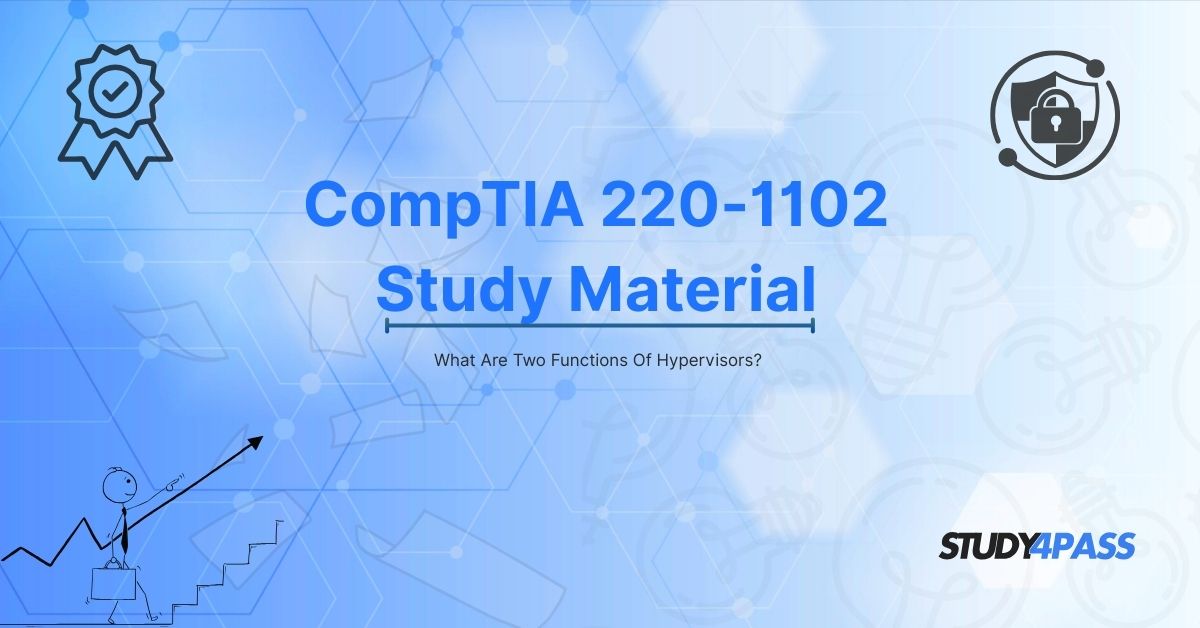Introduction to Functions of Hypervisors
The CompTIA A+ 220-1102 certification exam covers essential IT concepts, including virtualization and hypervisors. A hypervisor is a critical component in virtualization, allowing multiple operating systems (OS) to run on a single physical machine. Understanding its functions is vital for IT professionals.
In this guide, we will explore two primary functions of hypervisors and how mastering these concepts can help you pass the CompTIA 220-1102 exam. Additionally, we’ll highlight how Study4Pass provides the best study materials to ensure your success.
What Is a Hypervisor?
A hypervisor, also known as a Virtual Machine Monitor (VMM), is software, firmware, or hardware that creates and manages virtual machines (VMs). It enables multiple guest operating systems to run on a single host system by efficiently allocating computing resources.
There are two types of hypervisors:
- Type 1 (Bare-Metal Hypervisor) – Runs directly on the host’s hardware (e.g., VMware ESXi, Microsoft Hyper-V).
- Type 2 (Hosted Hypervisor) – Runs on top of an existing OS (e.g., Oracle VirtualBox, VMware Workstation).
Now, let’s discuss the two key functions of hypervisors relevant to the CompTIA 220-1102 exam.
Function 1: Resource Allocation and Management
One of the primary functions of a hypervisor is to allocate and manage hardware resources among multiple virtual machines.
How It Works:
- The hypervisor partitions physical resources (CPU, RAM, storage, network) and assigns them to VMs.
- Ensures that no single VM monopolizes resources, maintaining system stability.
- Uses dynamic resource allocation to adjust resources based on demand.
Why It Matters for CompTIA 220-1102:
- Understanding resource allocation helps troubleshoot performance issues in virtualized environments.
- Questions on the exam may cover how hypervisors optimize CPU and memory usage.
Study4Pass Advantage:
Study4Pass provides detailed explanations and real-world scenarios on hypervisor resource management, helping you grasp these concepts quickly. Their practice exams simulate actual test questions, ensuring you’re fully prepared.
Function 2: Isolation of Virtual Machines
Another critical function of hypervisors is providing isolation between virtual machines.
How It Works:
- Each VM operates independently, unaware of other VMs running on the same host.
- If one VM crashes or gets infected with malware, others remain unaffected.
- Enhances security and stability in multi-tenant environments (e.g., cloud computing).
Why It Matters for CompTIA 220-1102:
- Exam questions may focus on security benefits of VM isolation.
- You might encounter scenarios where isolating VMs prevents system-wide failures.
Study4Pass Advantage:
Study4Pass offers interactive labs and simulations that demonstrate VM isolation in action. Their study guides break down complex topics into easy-to-understand sections, making exam preparation efficient.
How Study4Pass Helps You Master Hypervisors for CompTIA 220-1102?
When preparing for the CompTIA 220-1102 exam, choosing the right study materials is crucial. Study4Pass stands out as the best platform for the following reasons:
- Comprehensive Study Guides – Covers all exam objectives, including virtualization and hypervisors.
- Realistic Practice Tests – Mimics the actual exam format, helping you identify weak areas.
- Hands-On Labs – Provides virtual environments to practice hypervisor configurations.
- Expert Explanations – Simplifies complex topics with clear, concise language.
Unlike other platforms, Study4Pass focuses exclusively on your success, offering up-to-date, exam-aligned content that ensures you pass on your first attempt.
Final Words
Hypervisors play a crucial role in virtualization by allocating resources efficiently and isolating virtual machines for security and stability. Mastering these concepts is essential for the CompTIA 220-1102 exam.
For the best study materials, practice tests, and interactive labs, Study4Pass is the ultimate resource. Their structured approach ensures you understand hypervisors and other key topics, helping you ace the exam with confidence.
Start your journey to CompTIA Certification success today with Study4Pass – your trusted partner in IT exam preparation!
Special Discount: Offer Valid For Limited Time “CompTIA 220-1102 Study Materials”
Actual exam question from CompTIA's A+ 220-1102 Exam.
Sample Questions for CompTIA 220-1102 Certification
1. Which of the following are key functions of a hypervisor? (Choose two.)
A. Managing physical network hardware
B. Allocating computing resources to virtual machines
C. Providing internet connectivity to guest OS
D. Isolating virtual machines from each other
2. What are two primary roles of a hypervisor in virtualization? (Choose two.)
A. Running antivirus scans on guest systems
B. Enabling multiple VMs to share the same physical hardware
C. Directly controlling peripheral devices like printers
D. Ensuring VMs operate independently of each other
3. Which two tasks does a hypervisor perform? (Choose two.)
A. Installing operating systems on physical servers
B. Partitioning CPU and memory for virtual machines
C. Encrypting all data stored on virtual disks
D. Monitoring and managing VM performance
4. What are two functions provided by a hypervisor? (Choose two.)
A. Creating and deleting virtual switches
B. Allowing multiple operating systems to run on a single host
C. Automatically updating guest OS software
D. Preventing VMs from interfering with each other
5. Which of the following describe hypervisor capabilities? (Choose two.)
A. Assigning storage space to virtual machines
B. Converting physical machines into virtual machines
C. Providing graphical user interfaces for VMs
D. Enforcing security policies between VMs


